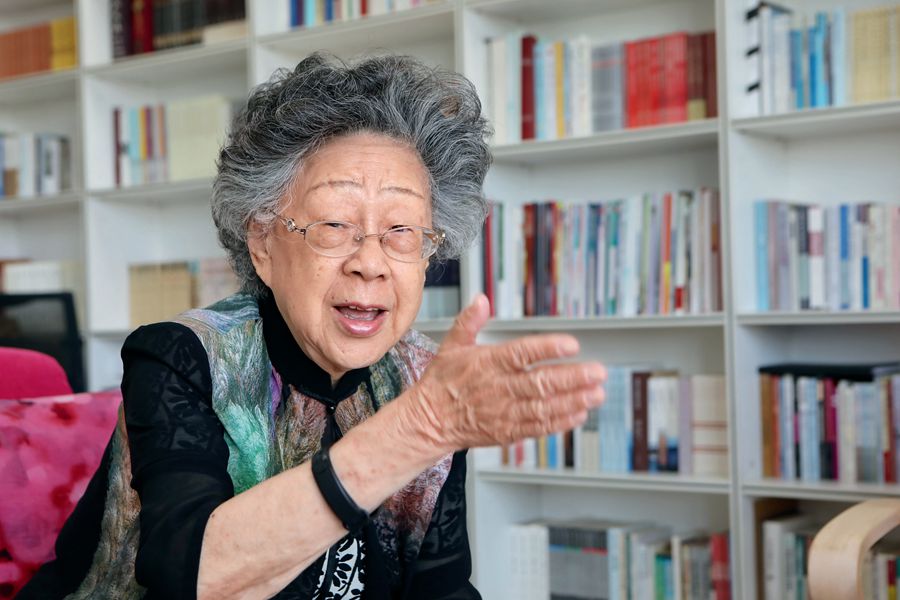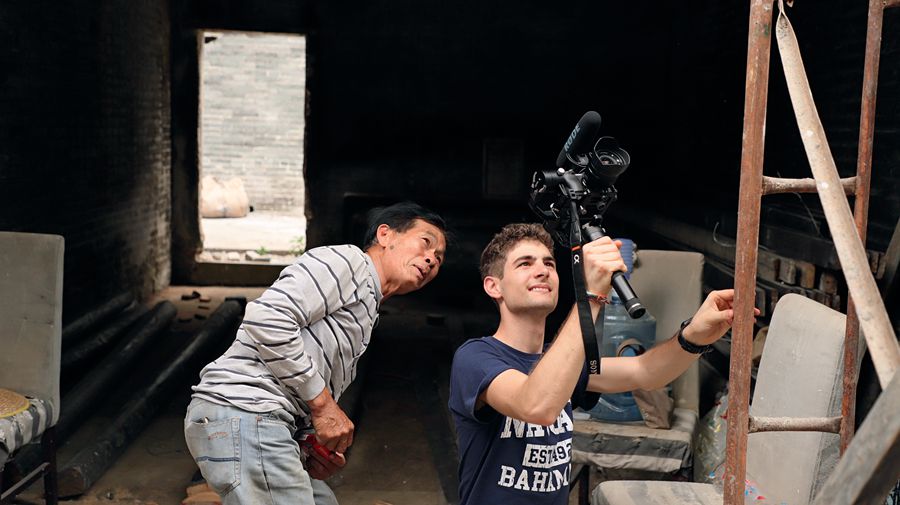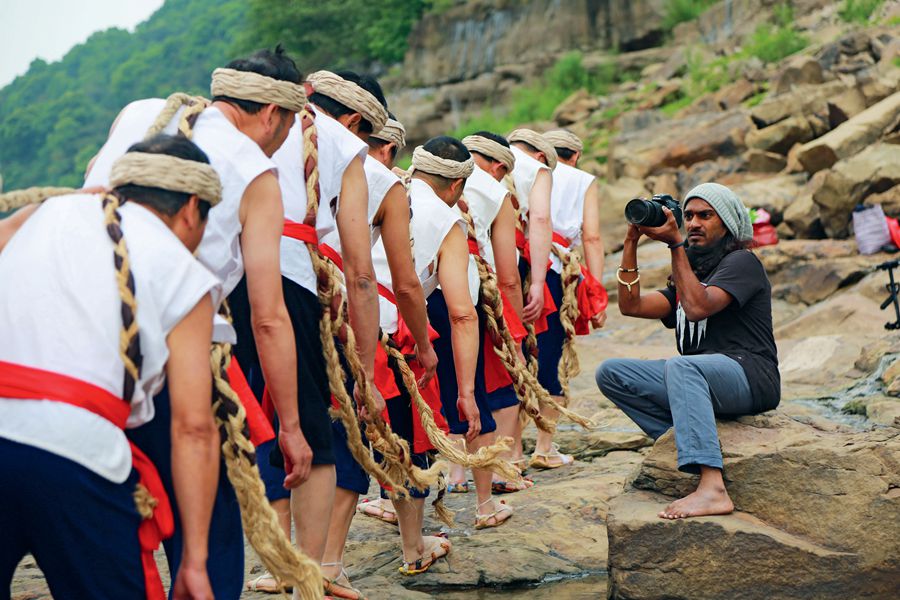“How can China have such a beautiful airport?” That’s the question blurted out from nine Boston University students when their plane landed at Terminal 3 at Beijing Capital International Airport. It was seven years ago, but the scene remains etched in the memory of Huang Huilin, director of the Academy for International Communication of Chinese Culture (AICCC) at the Beijing Normal University and founder of the Looking China Youth Film Project.

Huang Huilin (born in 1934) is Professor Emeritus of Beijing Normal University and Dean of the Academy for International Communication of Chinese Culture (AICCC) of BNU. Yu Jie
Organized by the AICCC and supported financially by the Huilin Foundation of the Beijing Normal University, the project gives young foreigners the opportunity to immerse themselves in Chinese culture, and then to express and share their impressions through videos. This initiative has been carried out annually since 2011, and it has garnered acclaim both in China and abroad. Today, it is a flagship project revealing the charm of China and showcasing the country’s culture.
During these seven years, over 400 young foreigners of various cultural backgrounds from some 40 countries came to China as part of their participation in the project. From the prosperous metropolises to the more remote western regions (Gansu and Ningxia), and from the three northeastern provinces (Heilongjiang, Jilin, and Liaoning) to the colorful southwestern provinces (Yunnan, Guizhou, and Sichuan) with diverse landscapes, they covered each of these regions and objectively recorded China as it stood before their eyes.
This is not only a new medium of international cultural exchanges, but a valuable personal experience as well as a journey of discovery to China.
Third Pole Culture
“Chinese culture is the legacy and continuity of a civilization of 5,000 years that has absorbed and been inspired by the quintessence of foreign cultures, and been further forged by Chinese revolutionary culture over the past century or more. And finally, along with contemporary European culture and American culture, the “third pole culture,” Chinese culture with socialist characteristics, has emerged, said Huang Huilin, a sprightly lady at the age of 85.
“Kids in kindergarten eat fast-food like McDonald’s and KFC, drink Coca-Cola, play with Ultraman toys, and say “yeah” to express their joy. None of these symbols are Chinese. From education to values, from aesthetics to daily life, we are surrounded by Western culture, and we are gradually moving away from our own culture,” said Huang. In 2008, Huang, who had been serving in the education sector for more than 50 years, had never before worried about the situation of Chinese culture so much. “Cultural products abound, but in a chaotic manner. Film and television productions try to imitate what exists abroad but fail to position themselves appropriately in the world. As a result, Chinese culture is struggling to find its place in the global cultural pattern.”

Bulgarian director Anastas is filming buildings at the Huitong Ancient Village in Zhuhai, a city in southern China.
For Huang, Chinese culture must first be strengthened before it can be exported abroad. China needs more confidence in its own culture, which does not mean being arrogant. In her opinion, the world culture is showing a multipolarity trend. In terms of influence, three cultural poles can be found. Although European culture and American culture are considered to be the two dominant cultural poles, Chinese culture, which is based on solid foundations and shows great vitality, deserves to be designated as a third pole culture. Rooted in traditional Chinese civilization, it advocates cultural diversity and respects cultural differences.
On November 19, 2010, the AICCC was established at Beijing Normal University. This institution, with Huang leading, is dedicated to academic research, artistic creation, cultural communication, and resource integration related to the third cultural pole. “The institute was co-founded by the Beijing Normal University and the US International Data Group (IDG). Through academic research on the dissemination of Chinese culture abroad and artistic creations rich in Chinese cultural characteristics that center on the third cultural pole, it promotes the transmission of Chinese culture around the world,” said Huang.
China in the Camera of Foreign Youths
“To be able to spread Chinese culture around the world, we need a good carrier beforehand. Through Chinese characters? No, because they are hard to learn. Through learning the language? No, because the Chinese language is unlike any other language. Video proved to be the most effective means of expression to overcome all these obstacles. That’s why in 2011, Huang led the institute to launch the “Looking China” project.
From the recruitment and selection of foreign apprentice directors, Huang sets her requirements. First, these young foreigners must never have set foot in China beforehand. Second, they must show a great curiosity and spirit of exploration towards the country and its culture. Finally, the young people selected must be equipped with some basic video production skills.

Indian director Tulasi Taraka Prabhu Tej is filming in Chongqing.
In 2011, for the first session of Looking China, nine young students from Boston were selected. These nine children, on arriving at the T3 terminal at Beijing Capital International Airport, stayed there for a while, on the lookout for every detail, delaying to take the airport shuttle bus. That’s when they asked us, “How can China have such a good terminal? This terminal is even better than the JFK airport in New York! How is it possible?” At the time, Huang was very surprised by the reaction of these nine children.
After 10 days together, Huang understood better. Through discussions, she discovered that these nine children had a decades old image of China compared to the country they were discovering. In their minds, China was still similar to the film Red Sorghum: women with feet bandaged and men wearing hair in braids. According to Huang, in the past, China made many classic films of the same type as Red Sorghum. However, in the real world, China has developed and is nothing as seen in those productions. “The works are quite classic; however, they sometimes might leave a bad impression on foreign audiences.” Huang mentioned this story many times on different occasions. It is the reaction of several American youths that made her see the importance of her work and strengthened her will to do the project well.
As of 2017, the project had invited 405 young participants from 49 countries, including the U.S., Canada, the U.K., France, Italy, the Netherlands, Georgia, India, Singapore, South Korea, Israel, Australia, Brazil, and Argentina. They produced a total of 404 short films and garnered more than 90 international awards. Chinese President Xi Jinping, in his important speech at the National University of Singapore on November 7, 2015, mentioned the “Looking China” project, showing his strong endorsement of it.
Feeling the Charm
Among the many documentary short films made by these young foreigners, one of them, titled Chivalrous, particularly touched Huang. Daniel Salgarolo, a film student at Boston University, visited China for the first time in 2011. Before that, about China he knew only kung fu, tai chi, and Bruce Lee. The American student also wanted to shoot a film related to the Chinese kung fu or tai chi.
At that time, there was a massage school for the blind in Beijing. A professor surnamed Wan, from the Beihang University, taught tai chi to blind students in his spare time. The “Looking China” team took Daniel to watch the tai chi class. Impressed, Daniel decided that this place would become the setting for his film. “Once the movie was done, I asked Daniel how do the blind people learn tai chi when they cannot see the movements? He answered that you’ll find out watching my video,” Huang recalled.
The final version of the film left Huang amazed. She explains, “To teach tai chi, Professor Wan takes a certain position, then all the students come in to feel the teacher, from head to toe. In this way, they learn each position and movement. Following the broadcast of the short film, blind students learning tai chi from Professor Wan were invited to give a performance at the Great Hall of the People in Beijing.
“He told me that he discovered, by making this film, that Chinese kung fu was not just a combative sport and that it was more of a Chinese spiritual activity, embodying the values of “benevolence” and “justice” advocated in traditional Chinese culture. In tai chi, the strong do not bully the weak, but help the weak with a spirit of “benevolence” and “justice” characterizing the Chinese spirit. That’s why he chose the name Chivalrous for his film,” said Huang, highlighting Daniel’s creative grasp of the gist and essence of Chinese culture, which deserves being promoted broadly abroad.
“For the world to know China, we must focus on the younger generation. I hope that a growing number of young people interested in our initiative will join us in this adventure, and that with their wisdom and hard work, they will give the world the means to hear and see the new forces of Chinese culture,” said Huang.


